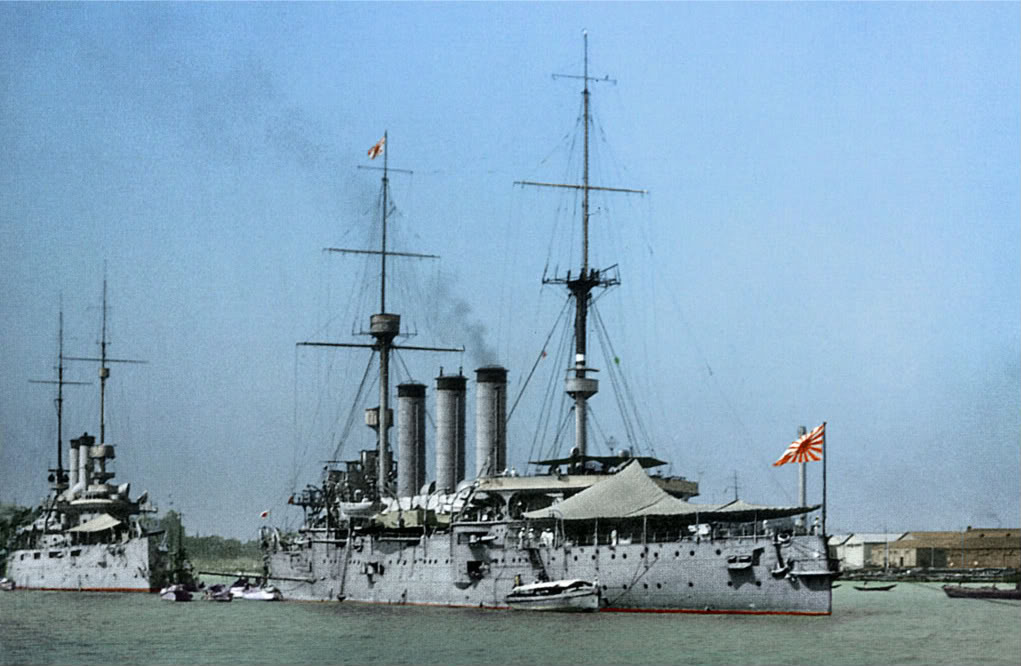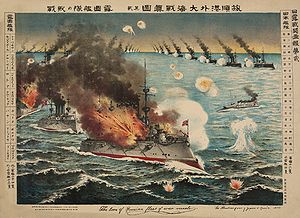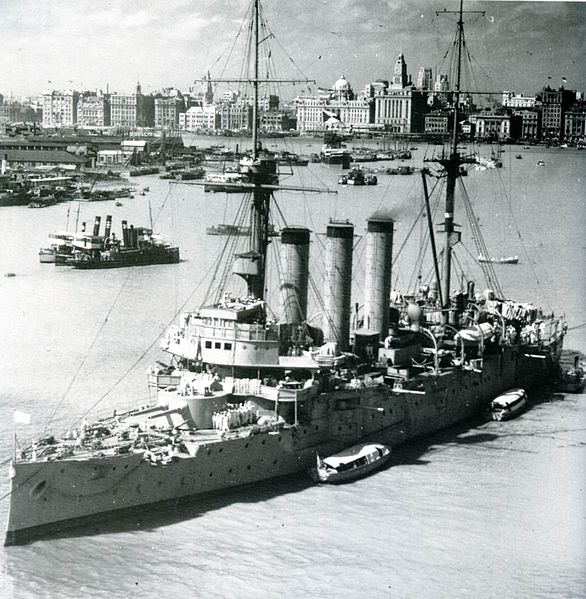Japan’s Charmed Warship
- By Peter Harmsen
- 11 May, 2014
- No Comments
 The most visible Japanese presence in Shanghai during the three-month battle for the city in the fall of 1937 was the cruiser Izumo, anchored in the Huangpu River. It was the flagship of Vice-Admiral Hasegawa Kiyoshi, commander of the Imperial Navy’s Third Fleet, and especially in the early part of the battle, its large guns turned out to be of great value for the defense of the narrow Japanese perimeter in Shanghai. At moments when the Japanese positions threatened to be overwhelmed by Chinese attack, they could call on the Izumo’s crew to rain down a deadly shower of steel.
The most visible Japanese presence in Shanghai during the three-month battle for the city in the fall of 1937 was the cruiser Izumo, anchored in the Huangpu River. It was the flagship of Vice-Admiral Hasegawa Kiyoshi, commander of the Imperial Navy’s Third Fleet, and especially in the early part of the battle, its large guns turned out to be of great value for the defense of the narrow Japanese perimeter in Shanghai. At moments when the Japanese positions threatened to be overwhelmed by Chinese attack, they could call on the Izumo’s crew to rain down a deadly shower of steel.
The Chinese immediately understood the tactical value of the Izumo, and the cruiser was the target of repeated attacks during most of the campaign. On the second day of the battle, August 14, a Chinese air raid on the ship ended tragically when four Chinese bombs released in error landed in the foreign part of Shanghai, killing and injuring hundreds, mostly Chinese. It would soon be known as “Bloody Saturday” or “Black Saturday.”

Naval battle during Russo-Japanese War
The Izumo’s ability to escape unscathed from every blow directed at it caused some of Shanghai’s expatriates to start wondering, half-seriously, if the vessel might be blessed by a charmed life. Rumors also began to proliferate. According to one of them, it was actually a vessel from the Czar’s old Navy, captured by the Japanese in the war with Russia of 1904 and 1905.
In the end, the Japanese Navy found it necessary to put the rumors to rest. “Inasmuch as the pedigree of the Izumo, flagship of Vice-Admiral Hasegawa, has been the cause of much conjecture among Shanghai civilians, Japanese spokesmen yesterday outlined the ship’s career,” the Shanghai-based North China Daily News reported on October 16, 1937.
The Izumo’s career was less exotic than some spectators might have hoped for. It had been built by the company Armstrong Whitworth in Newcastle upon Tyne as part of a large Japanese naval order and had been handed over to Japan in September 1900. It had indeed taken part in the Russo-Japanese War, but exclusively on the Japanese side. It had played a pivotal role in the legendary Battle of Tsushima, serving as the flagship of Admiral Kamimura Hikonojo. Later it was deployed in the First World War, when Germany was the enemy.
However, the Battle of Shanghai was the cruiser’s main claim to a place in the history books. When the struggle was over, the Izumo stayed in the city, and was to see action again at the start of the greater conflict in the Pacific. On December 8, 1941, in an action planned in parallel with the attack on Pearl Harbor, the Izumo sank the British river gunboat HMS Peterel, also anchored in the Huangpu River. The brief, bloody battle was described by British author J. G. Ballard in his novel Empire of the Sun, using alternative spellings for the two vessels:
“From its moorings beside the Japanese Consulate the cruiser Idzumo had also opened fire. Its guns flashed through the smoke that rose from its three funnels and curled along the water like a black feather boa. Already the Petrel was hidden within a pall of steam, below which a series of raging fires were reflected in the water.”
As the war turned bad for the Japanese, the Izumo went the way of much their Navy – to the bottom of the sea. In this case, however, the ocean was not so deep. It was sunk by US airplanes in the summer of 1945 while docked in the port city of Kure near Hiroshima. Two years later it was raised and scrapped.
But the myths lived on, helped by, among others, famed US aviator Claire Chennault, who had been in Shanghai in 1937. When he wrote his memoirs, Way of a Fighter, in 1949, he reiterated the story that the Izumo was “taken from the Russians in 1904.”




 Copyright © 2025
Copyright © 2025
Leave a Reply